When To Stop Crate Training Your Puppy
This post may contain affiliate links. We may earn money or products from the companies mentioned in this post.
When to stop crate training may seem counterintuitive to research as crate training is a valuable tool for so many reasons, right?
It teaches our furry friends good behavior, helps establish a routine and limits accidents inside the home, especially during their early stages.
However, there usually comes a time when your pup can transition away from a closed crate and become more independent.
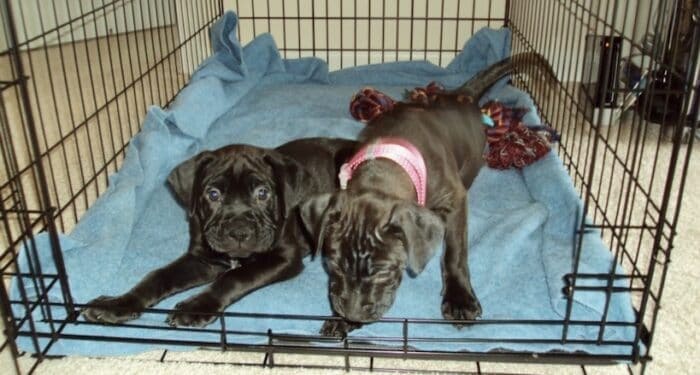
Puppies Buzz (left) and Missy (right) in their crate
But determining when to stop crate training can be a bit of a challenge as every dog is unique.
For instance, both my Boxer mixes and my Feist mix graduated from crate training when they were about 2 years old while some of my client dogs were done earlier, and others much later.
So in this blog post, I’ll explain what exactly that meant for all of them along with key factors to consider and insights on when to stop crate training your furry friend.
Assess Your Dog’s Crate Training Progress
Before I dive into today’s topic, let me clarify that I assume you’re on board with crate training your puppy to help establish house training routines and prevent destructive behavior.
That being said, this blog post does not cover how to start crate training your puppy, but what we can tell you here is that our favorites crates are the ones by Midwest homes!
If you’re interested in learning how to crate train your puppy in 5 easy steps, please click here.
For tips on how to stop your puppy from barking in his crate at night, click here.
Your Dog’s Age and Maturity
Now, as puppies grow older, they become more reliable with their bathroom habits.
Once you notice that they start to display trustworthy behavior when you leave them alone, you can start gradually reducing their crate time.
Below, I’ll outline several key factors that will help you evaluate if your pup has reached a stage where they can handle increased freedom.
Potty Training
That’s your first prerequisite on your road to stop crate training.
Does your pup consistently display reliable bathroom habits and doesn’t soil their kennel while crated?
This includes their time spent in the crate while someone’s home as well as when they’re home alone.
Of course this implies that they get frequent, age-specific bathroom breaks and aren’t stuck in their crates for too long.
For Missy & Buzz, I brought them home with me when they were 8 weeks old.
I put them up in their Midwest crates when I left them home alone, but also when I was home and couldn’t actively supervise them.
For example, at night, when I was in the bathroom, busy cooking dinner in the kitchen or doing laundry.
When I fostered and later adopted my pup Wally, he was a little over one year old and I was told that he was reliably house trained.
However, I wasn’t entirely sure if the stress of being at a new home wouldn’t cause him to forget some of his house training, so I crated him following the same parameters as I did for Missy & Buzz.
While they were fully potty trained when they were about 7 months old, I still kept them in their crates when I couldn’t actively supervise them until they were 2 years old.
I followed the same time line for Wally, my rescue pup.
Read on for the remaining puzzle pieces on your way to stop crate training your pup besides the potty training one!
Your Dog’s Behavioral Development
Moving on beyond accidents, I recommend you observe your dog’s behavior both inside and outside the crate.
1. Excited Tinkles
Watch out for excited tinkles!
That’s what I called it when the pups occasionally peed a little when someone came over to our home.
While Missy & Buzz were house trained as far as not taking bathroom breaks inside, they still had those excited tinkles when the maintenance staff from our apartment complex came over to fix something.
As that was the case on a regular basis – don’t get me started on that topic – and we had wall to wall carpeting throughout most of our place, they stayed in their crates when people came over.
Maybe it would have helped for maintenance to ignore the pups, but they all loved dogs, so that wasn’t happening.
With Missy and Buzz, their excited tinkles stopped almost overnight when we moved from our apartment to a house.
They were about 1.5 years old at that time.
We still had occasional maintenance visits, but it was nowhere near as frequent as we did at our apartment. The person who came over was also really calm and did follow my instructions to ignore the pups!
For them, it was probably a combination of less excitement that came into the house and their natural progress in maturing.
One of my client puppies, Madison, also had excited tinkles whenever I came over to walk her during lunch.
She had them for a long time too, probably for about a year until they stopped.
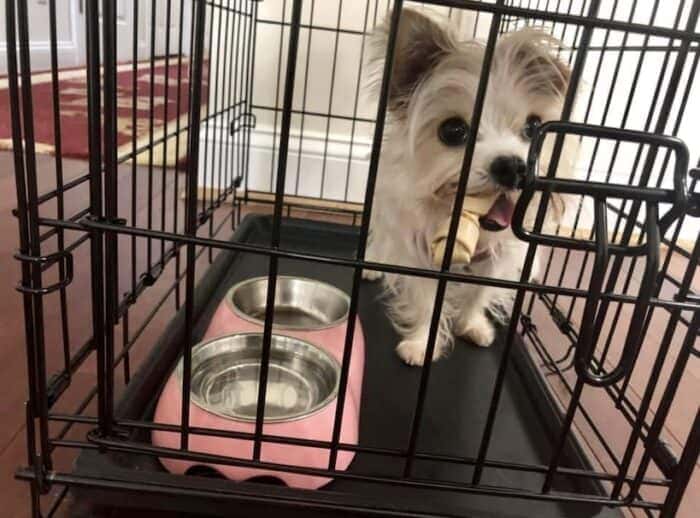
Morkie client puppy Madison in her crate
2. Counter Surfing & Fighting
Wally on the other hand neither had any stress-related accidents nor any excited tinkles, but he was counter surfing every chance that he got.
So until I taught him that behavior was a big no-no, he stayed in his kennel when I couldn’t actively supervise him.
Some of my client pups had a thing for clearing counters and tables too, which is why they remained crated as well although they were potty trained.
I specifically remember Sasha, Bella and Chester with those problems!
The picture below features Chester in the bottom crate and Bella in the top crate.
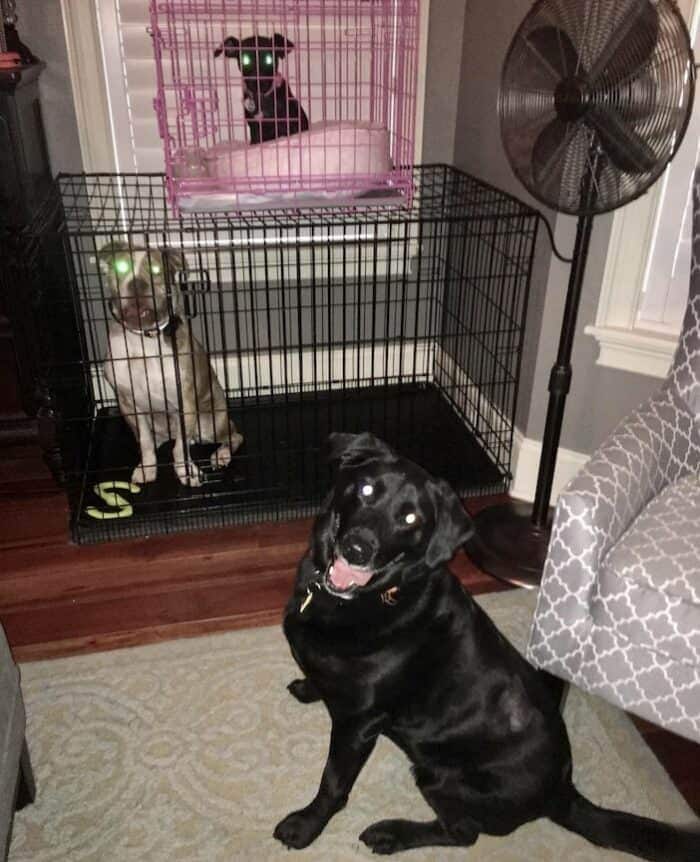
Chester, Bella and Macy
They stayed kenneled due to counter clearing issues, but also because they would start fights with each other.
Macy, who’s sitting in the front, was their senior by about 5 years.
She had earned her freedom from the crate when she had slowed down inside the house, which happened at 5 years of age.
Out of the three, she was definitely the calm, wise grandma pup – at least until it was time to play with her favorite ball outside! That’s when her puppy energy came back.
Rescue puppy Sasha, pictured below in the right crate, also put her paws up on the kitchen counter whenever the chance presented itself.
Additionally, she was a wild whirlwind inside the house and egged her adopted sister Myia on, so they both stayed crated when they were home alone.
I watched them until Sasha was about 3 years old and she still hadn’t graduated from her crate by then.
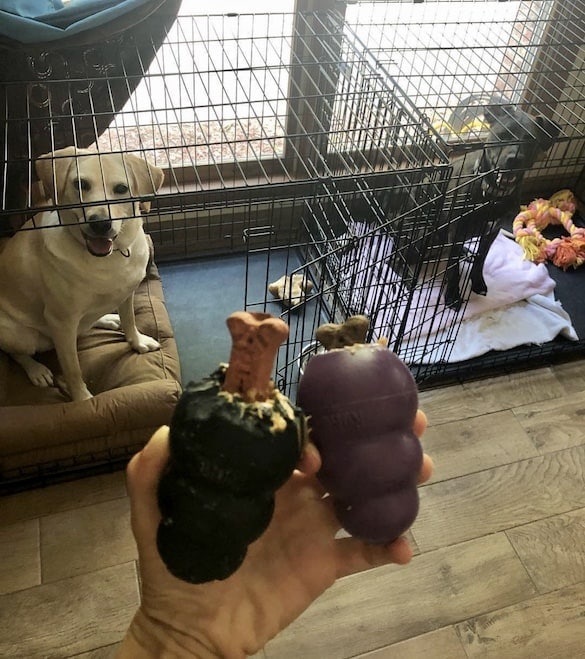
Myia (left) and Sasha (right) in their respective crates
3. Destructive Chewing
Thankfully, none of my personal pups chew(ed) on inappropriate items but I had a few dog walking and pet sitting clients who did.
For example, I remember my client pup Stanley, a German Shepherd who was house trained in record time but remained crated when home alone until he was about 2 years old.
His issue was that he would chew anything soft in sight, including his crate mat.
He eventually stopped, but I remember him having to stay in his crate without any bedding for a while.
By the way, if you scroll back up and look at Chester (the bully) in his crate, you’ll notice that he’s in there without any bedding as well.
He had the same issue as Stanley, so both had crate time “just” with dog chews.
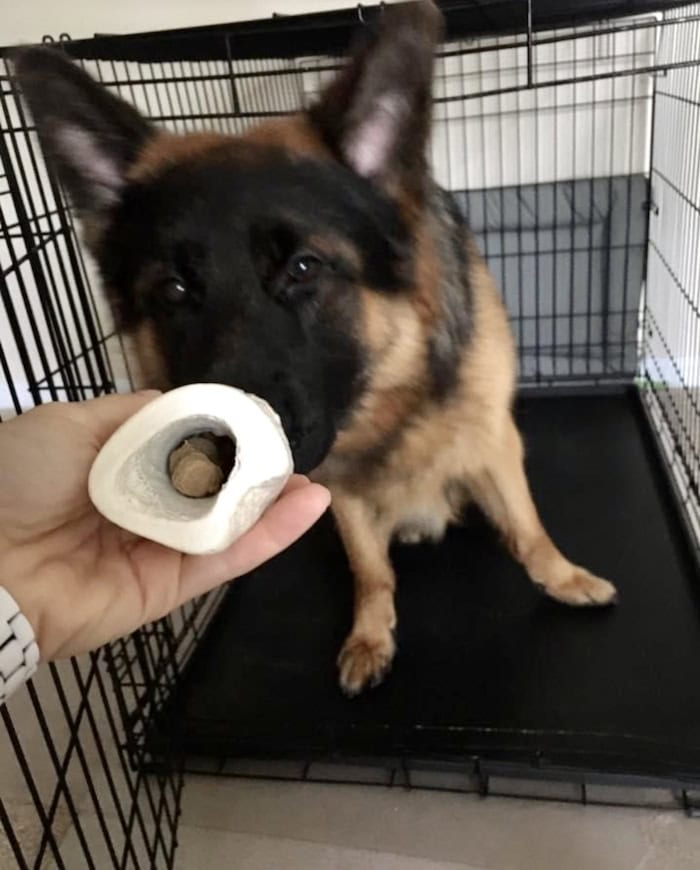
GSD puppy Stanley in his crate sans bedding
How Do I Transition My Dog From Crate To Free Roam?
So while it may take some time for your pup to outgrow their behavioral quirks, sooner or later they’re usually ready to move on.
However, I don’t recommend you stop crate training abruptly!
Instead, it’s best to introduce gradual freedom in a controlled manner.
1. Increase Crate-Free Time When You’re Home
Begin by allowing your pup short periods of supervised time outside the crate while you’re home with them.
Monitor their behavior during these supervised sessions.
You’ll want to make sure that the space they have access to is safe and doesn’t set them up for failure.
So for example, if your pup has a history of counter surfing, don’t leave tempting food sitting out.
Or if you know that your pups have a tendency towards excited tinkles like Missy & Buzz did, don’t give them supervised crate-free time when you’re aware of a scheduled maintenance visit.
Then observe how your dog responds.
If they behave appropriately and show no signs of anxiety or restlessness, you can gradually increase the duration of their free time.
If they act up, correct the behavior and work on counter conditioning them. Always try to be as calm as possible as yelling or frantic sobbing usually only make things worse.
Wally got more crate-free time about 3 months into living at my place.
By that time, he had settled into his new environment and I started actively working on my attempt of counter conditioning him – pun intended – when food was sitting on the counter.
What I would do is keep him on a leash that I tied to my fridge door while I was busy preparing food in the kitchen.
That was a way for me to actively catch him in the act of counter surfing, correct him and then reward him for leaving his paws off the counter!
About one month into implementing this strategy, I increased his freedom a bit more and took him off the leash.
He still wasn’t perfectly behaved but he attempted to steal food off the counter less and less.
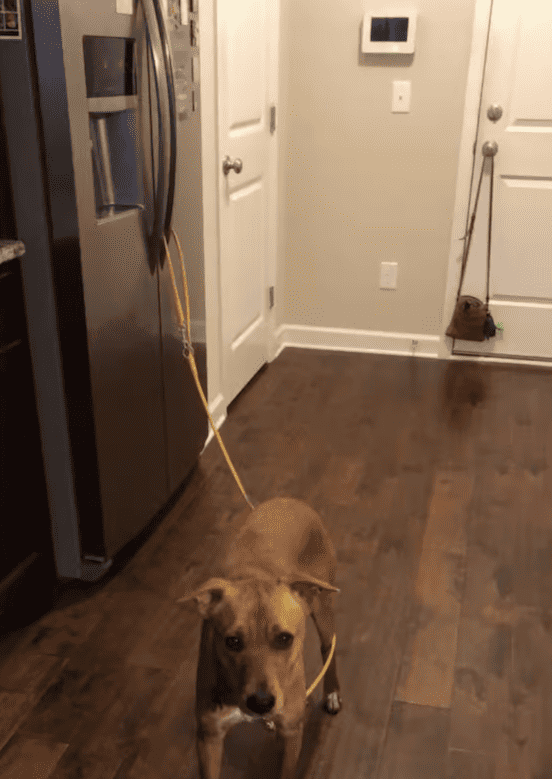
Wally leashed in the kitchen
2. Extended Supervised Freedom Outside Of The Crate
Once your pup demonstrates positive behavior during those shorter periods outside the crate, you can gradually increase the duration of their freedom.
But keep a watchful eye on them!
My Morkie client Madison graduated from her crate whenever someone was home with her. She made that transition when she was 2 years old.
So did all of my pups, bully Chester and his adopted sister Bella, and also Stanley the GSD.
3. Slowly Introduce Unsupervised Crate Time
Once your dog consistently behaves nicely during extended supervised freedom, slowly introduce short periods of unsupervised time.
Start with brief intervals, for example while you head out on a quick grocery run or pick your kids up from school.
Note that you don’t have to give them the entire run of your home quite yet. It’s enough to give them access to a smaller area, for example a hallway and/or your living room.
Close the doors to any rooms you don’t want your pup to have access to, and/or use baby gates to confine them to a specific area.
Tip: Exercise your pups before you leave them home alone, that way they’re more likely to be calm and well-behaved.
If a quick grocery run still seems like too much time home alone, start really small and just go get the mail.
Or step outside for 5 minutes and wait somewhere your pups can’t spot you from the inside.
Since Missy & Buzz pups would have been able to see me on the porch, I just walked over to a neighbor’s house and back.
Gradually increase these short times home alone as your dog proves trustworthy.
You Can Keep Using The Crate As A Safe Space For Your Dog
Once your pup no longer requires crate confinement, it’s crucial to provide them with an alternative safe space.
One option is to designate a cozy area in your home, such as a dog bed or a specific room they can retreat to and feel safe.
My client Bailey got a dog bed in the living room after she graduated from her crate at about 2 years of age.
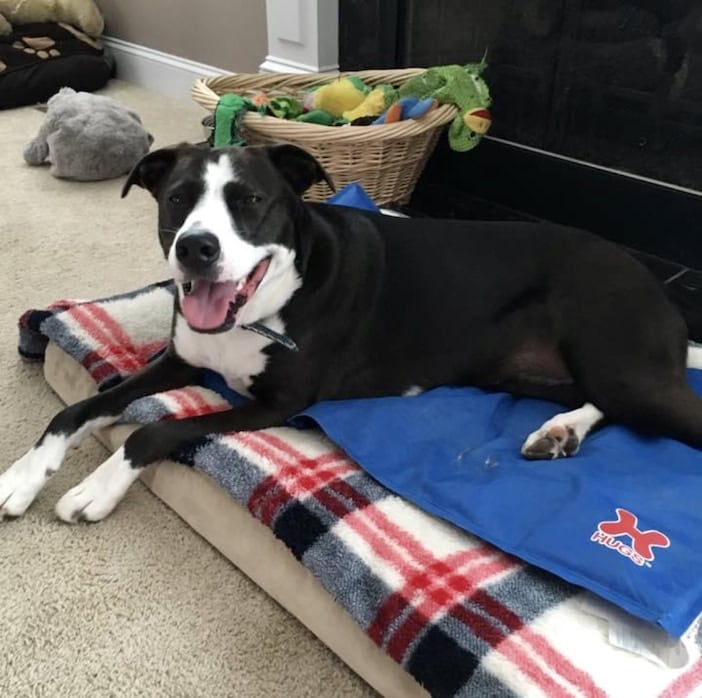
Bailey on her bed with a cooling pad
My client pup Madison transitioned from her crate to a doggie playpen when she was around 2 years old.
However, since she still had accidents when she was home alone and had the run of the house, this was the most freedom she could handle.

Morkie Madison in her playpen
But of course you can also leave your dog’s crates out without closing their doors.
That’s the approach I took for Missy, Buzz and Wally, and it’s also the one that most of my clients adopted.
That way, the pups could walk in and out of their crates as they wanted.
Bonus: If someone were to break into your home, your dogs are going to be much more “useful” outside of their crates than inside, especially if they’re larger pups!
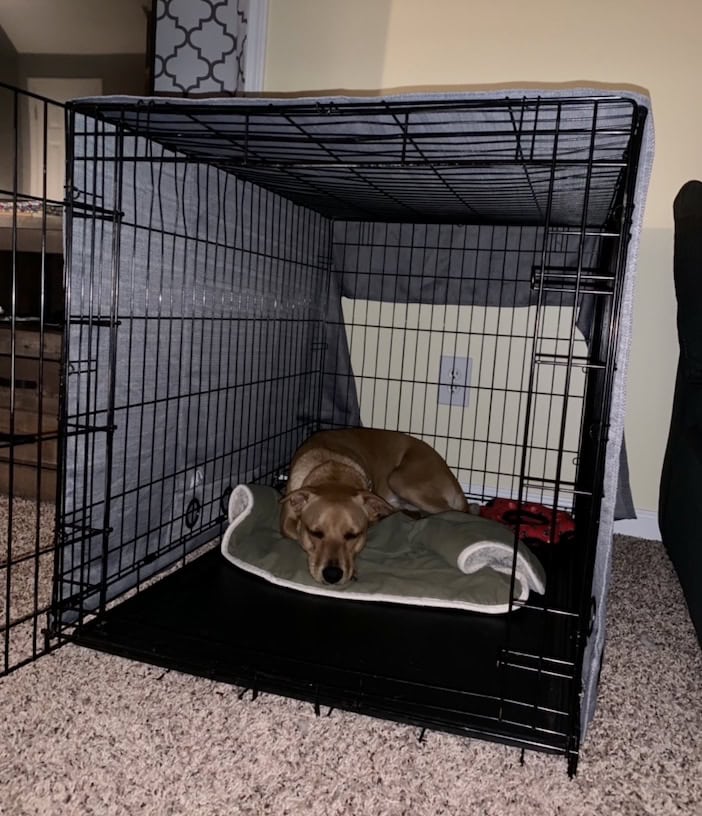
Wally in his open wire crate
Tools To Help Stop Crate Training
There are a few common denominators in the dogs’ lives I got to see graduate from their crates sooner than others, including my three guys.
Those are:
- Lots of physical exercise
- Mental stimulation like obedience training
- Interactive dog toys
- Optional: An indoor security camera
After all, tired dogs are more likely to be well-behaved.
During the phase when I slowly increased unsupervised crate time, I always started our days with a long (dog backpack) morning walk and practiced obedience commands.
So I’d ask them to “sit”, “lie down” etc while we were out walking.
When we got home, the pups were tired, ate breakfast in their open crate and then settled in for a long morning nap.
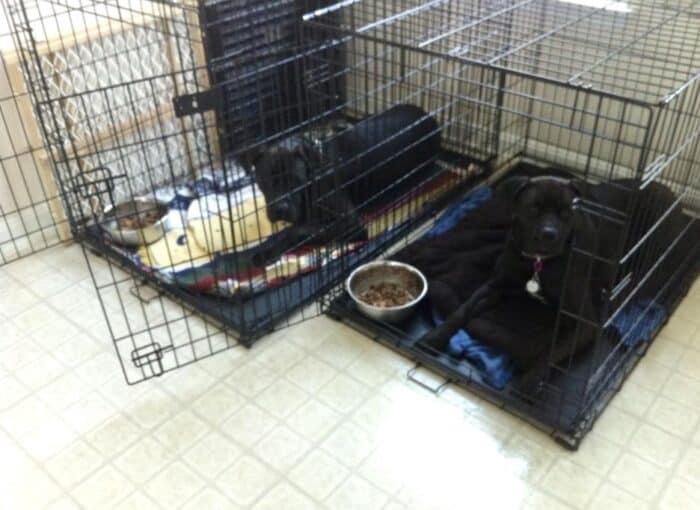
Missy (right) & Buzz (left) waiting for my command to eat in their crates
That’s when I left the house to take care of my pet sitting and/or dog walking client dogs.
I was gone for around 4 hours which I felt was the right time to test how the pups did outside of their crates.
Since they were tired and content after eating, there really wasn’t much they could get into.
Note: I set up an indoor security camera to be able to check in on the pups on my phone while I was gone.
What I observed was that they switched back and forth between napping in their crates, lounging on the couch and walking to the living room window to check on their backyard.
When I came home for lunch, the pups got a potty break in the yard for 30 minutes, and before I headed back out, I crated them along with a stuffed, frozen Kong dog toy each.
So while we were transitioning, there was no crate in the mornings followed by crate time in the afternoon.
At night, I left their crate doors open and gave them the choice between sleeping in their crates or on the couch (they used both).
I finally left the crate door open at all times when they were about 2 years old.
PRO TIP: It’s great when your puppy can successfully roam the house without supervision. However, even if you no longer need the crate as a tool to keep your puppy out of trouble we still recommend using it from time to time.
Why? Because you never know when you’ll need to use the crate again. Stetson was required to stay in his crate in between training sessions during K9 Nosework. Linus had to stay in a crate when he got sick and put on an IV.
It’s nice to know that they aren’t afraid (don’t get anxiety) to go back into their crate.
Bottom Line
Crate training is primarily used to provide a safe and secure space for your dog, prevent destructive behaviors, aid in house training, and establish a routine.
However, there comes a point when it may be appropriate to stop crate training and grant your furry friend more freedom.
That’s usually the case with dogs around 2 years of age.
Signs of good behavior to look out for are:
- No potty accidents in your home
- Reduced chewing on inappropriate items
- Reduced scratching at doors
- No excessive barking
As long as dogs still have accidents or struggle with separation anxiety when you give them more freedom, it’s too soon to stop crate training.
In case of specific issues that seem to drag on, you may want to seek guidance from a professional dog trainer or animal behaviorist to address them before transitioning away from the crate.
Remember, every dog is unique, so be patient, consistent, and understanding on your journey to stop crate training.
When did you stop crate training and what were your challenges along the way?
Let us know in the comment section below!
Save To Pinterest
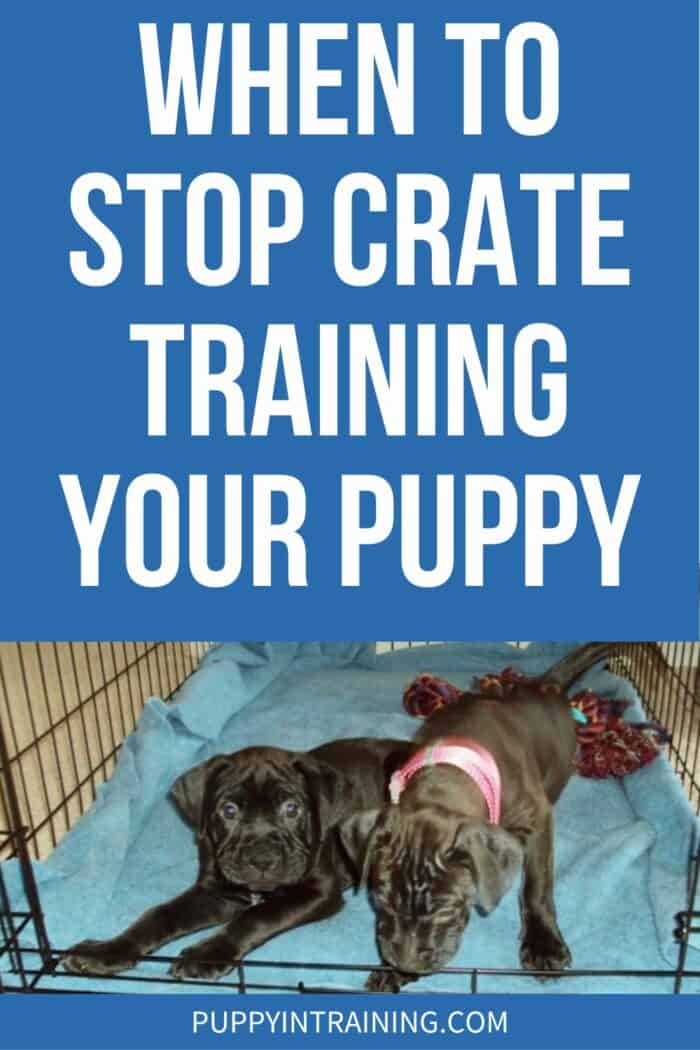
Top Picks For Our Puppies
- BEST DOG CHEW
We Like: Beef Collagen Sticks - All of our pups love to bite, nip, and chew. We love using Collagen Sticks to help divert these unwanted behaviors. - BEST PUPPY TOY
We Like: Calmeroos Puppy Toy w/ Heartbeat and Heat Packs - Perfect for new puppies. Helps ease anxiety in their new home. - BEST DOG TREATS
We Like: Crazy Dog Train-Me Treats - We use these as our high-value treats for our guide dog puppies. - BEST FRESH DOG FOOD
We Like: The Farmer's Dog - A couple months ago we started feeding Raven fresh dog food and she loves it! Get 50% off your first order of The Farmer's Dog.
Check out more of our favorites on our New Puppy Checklist.